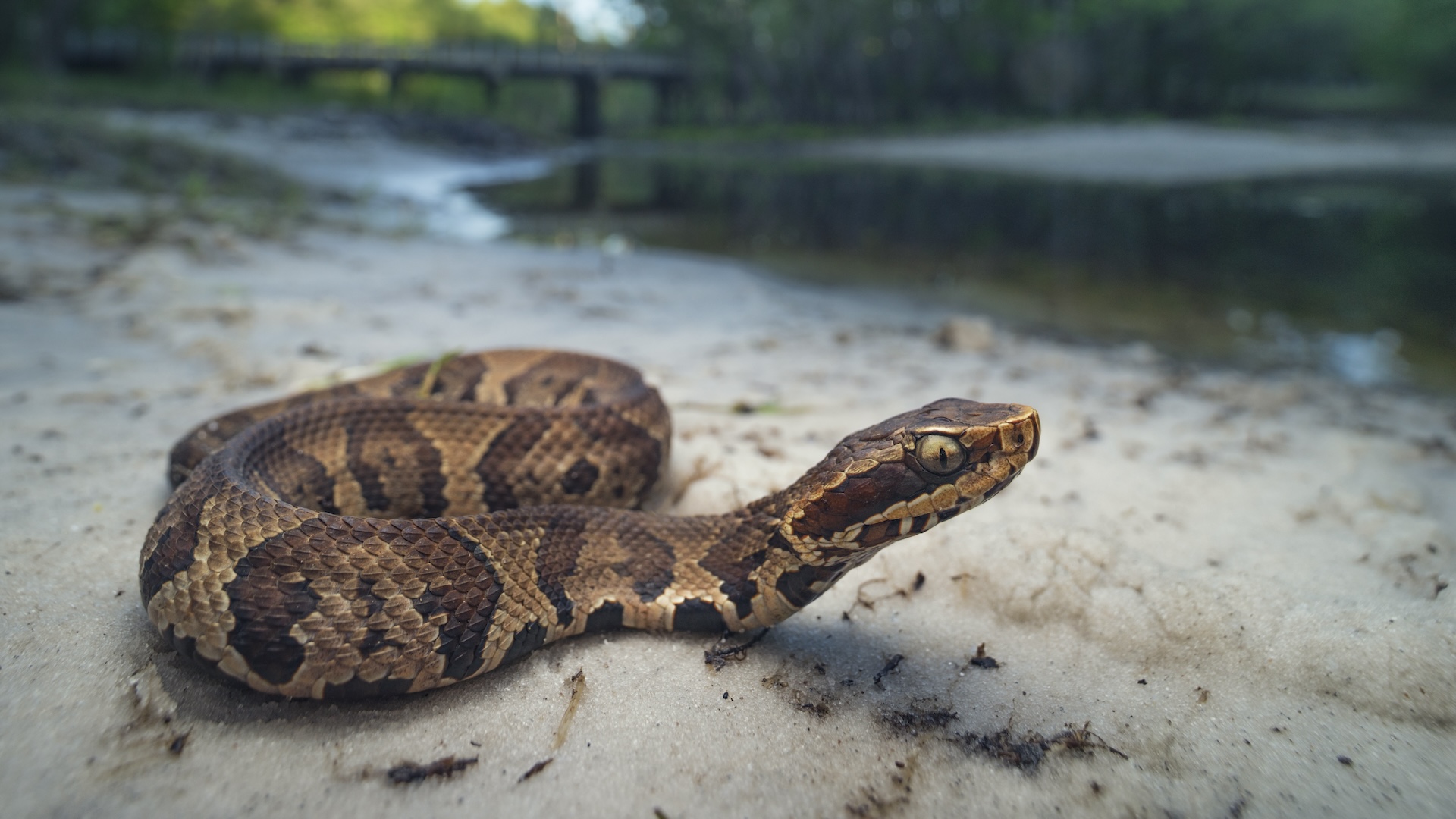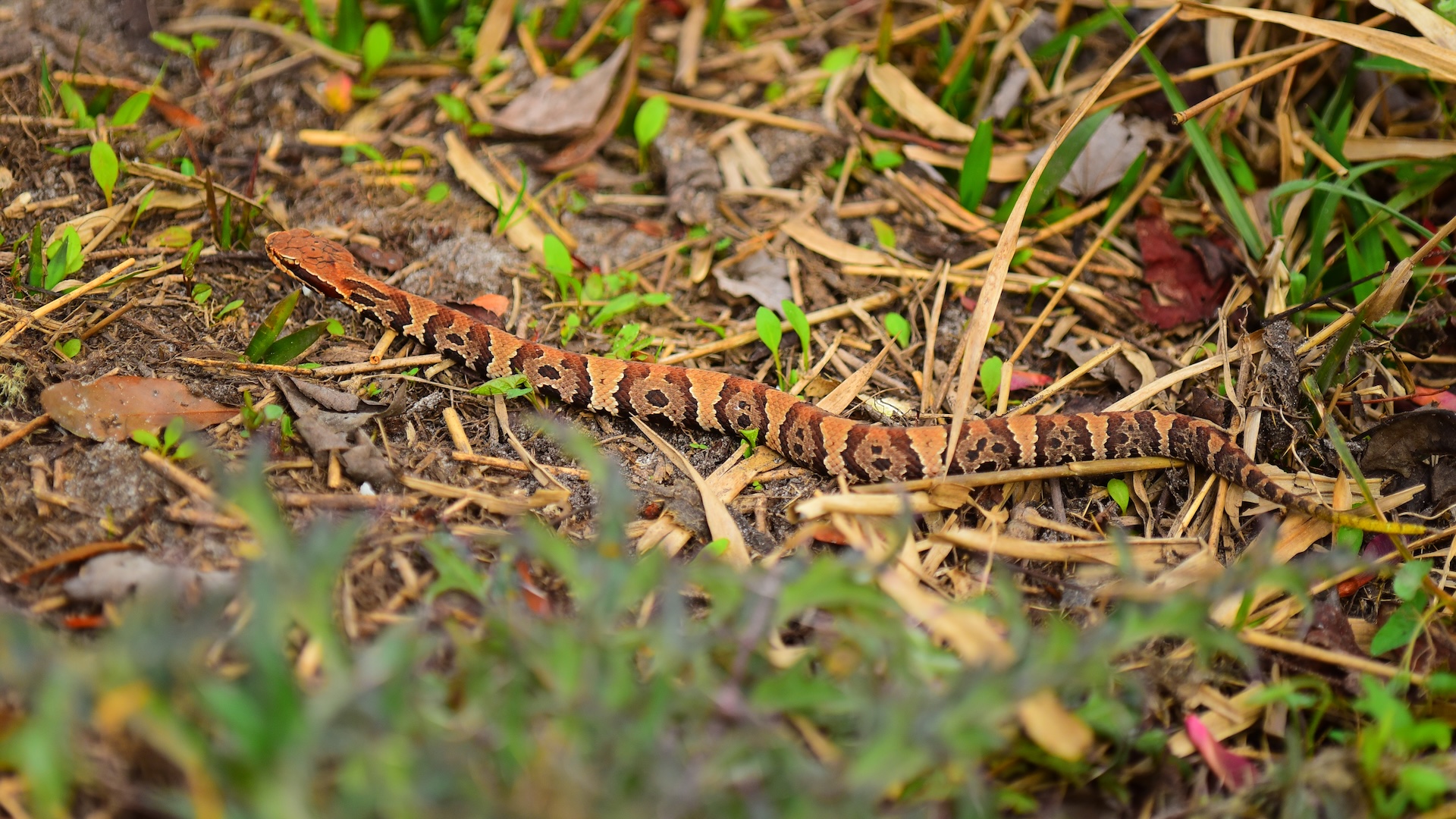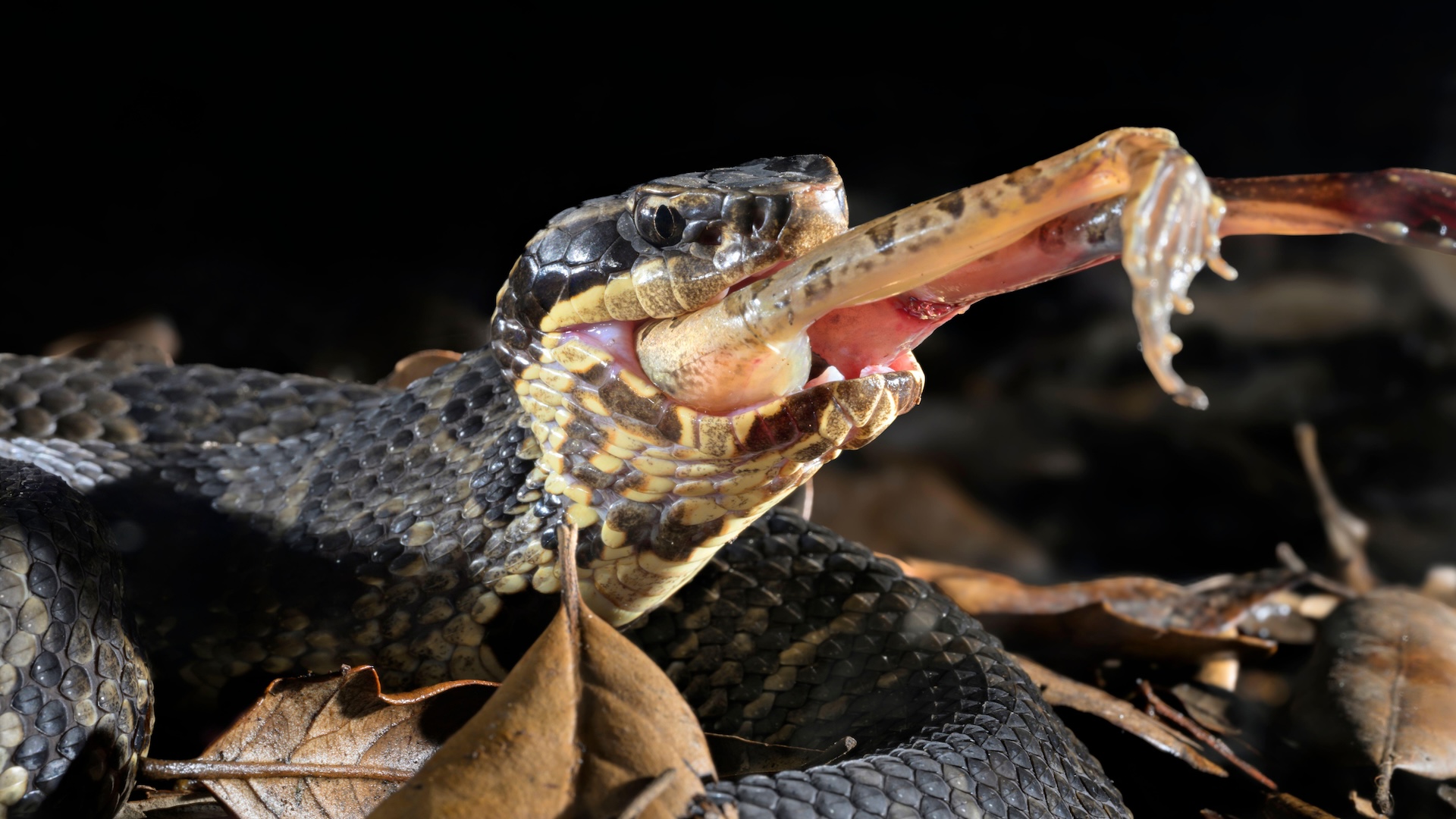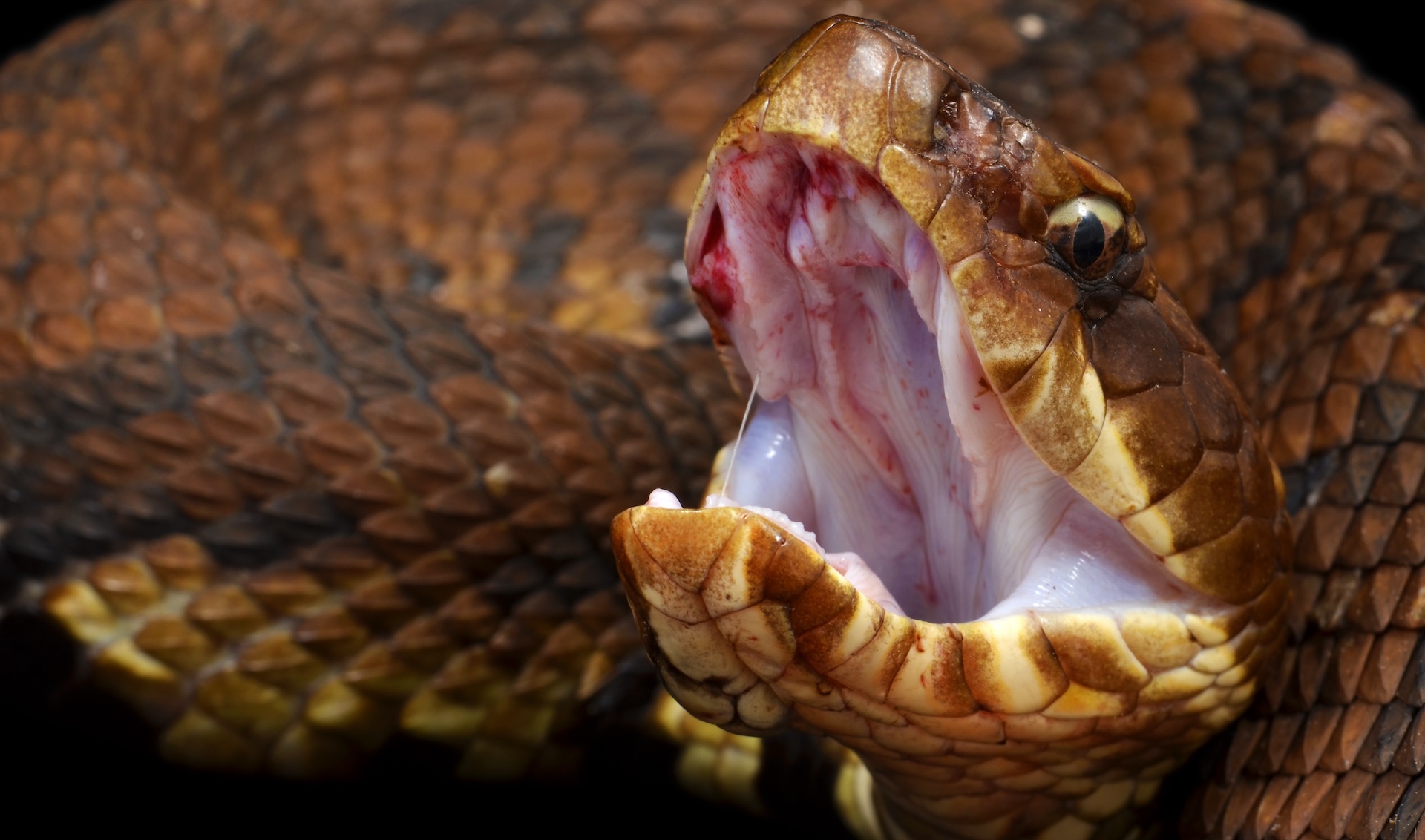
Cottonmouths (Agkistrodon piscivorus), or water moccasins, are venomous snakes found in the southeastern United States. They're called cottonmouths because the insides of their mouths, which they display when threatened, are white.
Cottonmouths are semiaquatic, so they're comfortable both swimming in water and basking on land. They are the only venomous snake in the U.S. that spends a lot of time in the water, Live Science previously reported. Other local names for cottonmouths include black moccasins, gapers, mangrove rattlers, snap jaws, stub-tail snakes, swamp lions, trap jaws, water mambas and water pilots.
Cottonmouths are pit vipers, as are copperheads and rattlesnakes, Sara Viernum, a herpetologist based in Portland, Oregon, told Live Science. "Like all pit vipers, [cottonmouths] have heat-sensing facial pits between their eyes and nostrils," Viernum said. These specialized pits detect minute temperature differences in order to accurately strike the source of heat, which is often potential prey. Cottonmouths rarely bite humans and usually do so only when provoked.
How to identify a water moccasin
Cottonmouths are relatively large, ranging from 30 to 48 inches (76 to 122 centimeters)long, according to the Florida Museum. They have thick, muscular bodies covered in ridged scales, as well as blocky heads with large jowls. Their pupils are vertical, similar to a cat's, and they have dark stripes next to each nostril. Their colors range from dark brown or black to olive, banded brown or yellow.
Cottonmouths are often confused with nonvenomous water snake species from the genus Nerodia. Cottonmouths and Nerodia species have similar coloring and patterns and are usually found near water. Even though water snakes are nonvenomous, they can still bite and are often killed by humans out of fear that the snakes are cottonmouths.
There are a few ways you can tell a nonvenomous water snake from a venomous cottonmouth, according to the University of Florida. Water snakes are skinnier and lighter than cottonmouths. Water snakes also have longer, thinner tails, and their heads are as wide as their necks. Water snakes' pupils are round, not vertical. Water snakes also lack the facial pits that are characteristic of pit vipers, including cottonmouths.
Kingdom: Animalia
Phylum: Chordata
Class: Reptilia
Order: Squamata
Family: Viperidae
Genus & species: Agkistrodon piscivorus
Source: ITIS
When threatened, nonvenomous water snakes — such as common water snakes (Nerodia sipedon) and banded, or southern, water snakes (Nerodia fasciata) — often try to appear bigger than they are by flattening their bodies and heads. This flattening makes them look more like cottonmouths. A water snake's flattened head will look more triangular but not as blocky and thick as a cottonmouth's head. A water snake's head will also still be a similar width to the neck, even when flattened. Trying to kill a snake greatly increases the risk of being bitten by one, according to the University of Florida.
Juvenile cottonmouths have more distinctive bands across their bodies and are lighter brown than adults. Juveniles also have bright-yellow tail tips that they use to attract prey. "They undulate the tail tip slowly back and forth to lure prey, such as frogs, within striking distance," Viernum said. The striking patterns on the juveniles fade with age.

Cottonmouth vs. Water Moccasin
Are they the same thing?
Cottonmouth and water moccasin are interchangeable terms for the venomous water snake.
Where do cottonmouths live?
Cottonmouths' range extends from southeastern Virginia to Florida, west to central Texas and north to southern Illinois and Indiana, according to the International Union for Conservation of Nature (IUCN). They live primarily in aquatic and wetland habitats, including swamps, marshes, drainage ditches, ponds, lakes and streams.
Cottonmouths can be seen year-round during the day and at night, but they primarily hunt after dark, especially in the summer, according to the Savannah River Ecology Laboratory. They can be found basking in the sun during the day on rocks, logs and stumps, according to the Virginia Department of Wildlife Resources.
There are three subspecies of cottonmouth recognized by the Integrated Taxonomic Information System (ITIS): Florida cottonmouths (Agkistrodon piscivorus conanti), found throughout Florida; western cottonmouths (Agkistrodon piscivorus leucostoma), found in Indiana, Illinois, Alabama, Oklahoma and Texas; and eastern cottonmouths (Agkistrodon piscivorus piscivorus), found in Georgia, South Carolina, North Carolina and southeastern Virginia.
Identifying the different subspecies is difficult. Their markings vary considerably, and the subspecies can interbreed where their ranges overlap.
What do water moccasins eat?

Cottonmouths hunt prey in water or on land. They eat fish, small mammals, birds, amphibians and reptiles, including other snakes and even smaller water moccasins, according to the University of Michigan's Animal Diversity Web (ADW). Cottonmouths kill with a single, venomous bite, and then squeeze prey until it stops moving, before swallowing their food whole.
Cottonmouths mate in the spring, usually from April to May. During the mating process, males slither around, waving their tails to lure females away from other male suitors. The males also fight each other when competing for females. Females have a gestation period of five months. Cottonmouths are ovoviviparous, which means that eggs incubate inside the mother's body. Females give birth to live young every two to three years, in litters of about 10 to 20 offspring, according to ADW.
Baby cottonmouths go off on their own as soon as they're born. Most baby cottonmouths don't make it to adulthood because they are eaten by other animals, such as raccoons, cats, eagles and snapping turtles.
Experts don't really know how long cottonmouths can live. According to the Texas Parks and Wildlife Department (TPWD), cottonmouths live less than 10 years in the wild. However, the snakes can live much longer in captivity, and at least one captive cottonmouth has lived to be over 24 years old, according to ADW.
Cottonmouths may hibernate in the winter in the colder, northern parts of their range. They hibernate in burrows made by other animals, including crayfish and tortoises, or under some other form of cover, such as rotting stumps, according to the IUCN.
Are water moccasins aggressive?
Cottonmouths rarely bite humans unless they are picked up or stepped on. They may stand their ground against potential predators, including humans, by using defensive behaviors.
"When a cottonmouth feels threatened, it will coil its body and open its mouth wide to expose the white coloration of the inside of its mouth," Viernum said. The flash of white contrasts with the snake's dark body colors to create a startling display. "Exposing the white of the mouth serves as a warning signal to potential predators," Viernum said.
Cottonmouths may also deter predators by spraying a foul-smelling musk from glands in the base of their tail, according to the Florida Museum of Natural History. Cottonmouths can also shake their tails, a bit like rattlesnakes, and can make a vibrating sound by doing so. But they don't have an actual rattle like rattlesnakes do.

Cottonmouth bite
Although cottonmouths rarely bite humans, cottonmouth venom can be deadly. Anyone who suffers a cottonmouth bite should seek medical attention immediately. The sooner antivenom can be administered, the sooner irreversible damage from the venom can be stopped, according to the Centers for Disease Control and Prevention (CDC). The CDC recommends that, after calling for emergency services, snakebite victims (or someone aiding them) should take a photo of the snake (from a safe distance) if possible, remain calm and apply first aid while waiting for emergency medical service personnel to arrive.
Humans bitten by pit vipers, including cottonmouths, will almost always feel an immediate burning pain where they've been bitten, and these bite wounds usually begin to swell within five minutes, according to the TPWD. Skin discoloration around the wound is also common.
Cottonmouth venom is composed mainly of hemotoxins that break down blood cells, preventing blood from clotting, according to Viernum. The hemotoxins lead to "hemorrhaging throughout the circulatory system wherever the venom has spread," she said. Being bitten and injected with cottonmouth venom can lead to "temporary and/or permanent tissue and muscle damage; loss of an extremity, depending on the location of the bite; internal bleeding; and extreme pain around the injection area," Viernum added.
Around 7,000 to 8,000 people are bitten by venomous snakes in the U.S. each year, but only about five to six people die from their bites, according to the University of Florida. Cottonmouths have accounted for less than 1% of all snakebite deaths in the U.S., according to the TPWD.
Conservation status
Cottonmouths are categorized as a species of least concern on the IUCN Red List of Threatened Species, which means that across nearly all of its range, the species is at low risk of extinction. Cottonmouths have a wide distribution, and the IUCN presumes that the cottonmouth population is large and relatively stable.
Many cottonmouths live in protected state and national parks, and the species is also protected by state law in some places. In Missouri, for example, all snakes are protected from being killed, including cottonmouths, according to the Missouri Department of Conservation.
Additional resources
Read about the effects of cottonmouth venom in the book "Water Moccasin Snake Toxicity" (StatPearls Publishing, 2020), look at pictures of these colorful snakes in the Illustrated book "U.S. Guide to Venomous Snakes and Their Mimics" (Skyhorse, 2019), or get more information about cottonmouths from the Virginia Herpetological Society.
Updated on Live Science Jul. 11, 2024.







